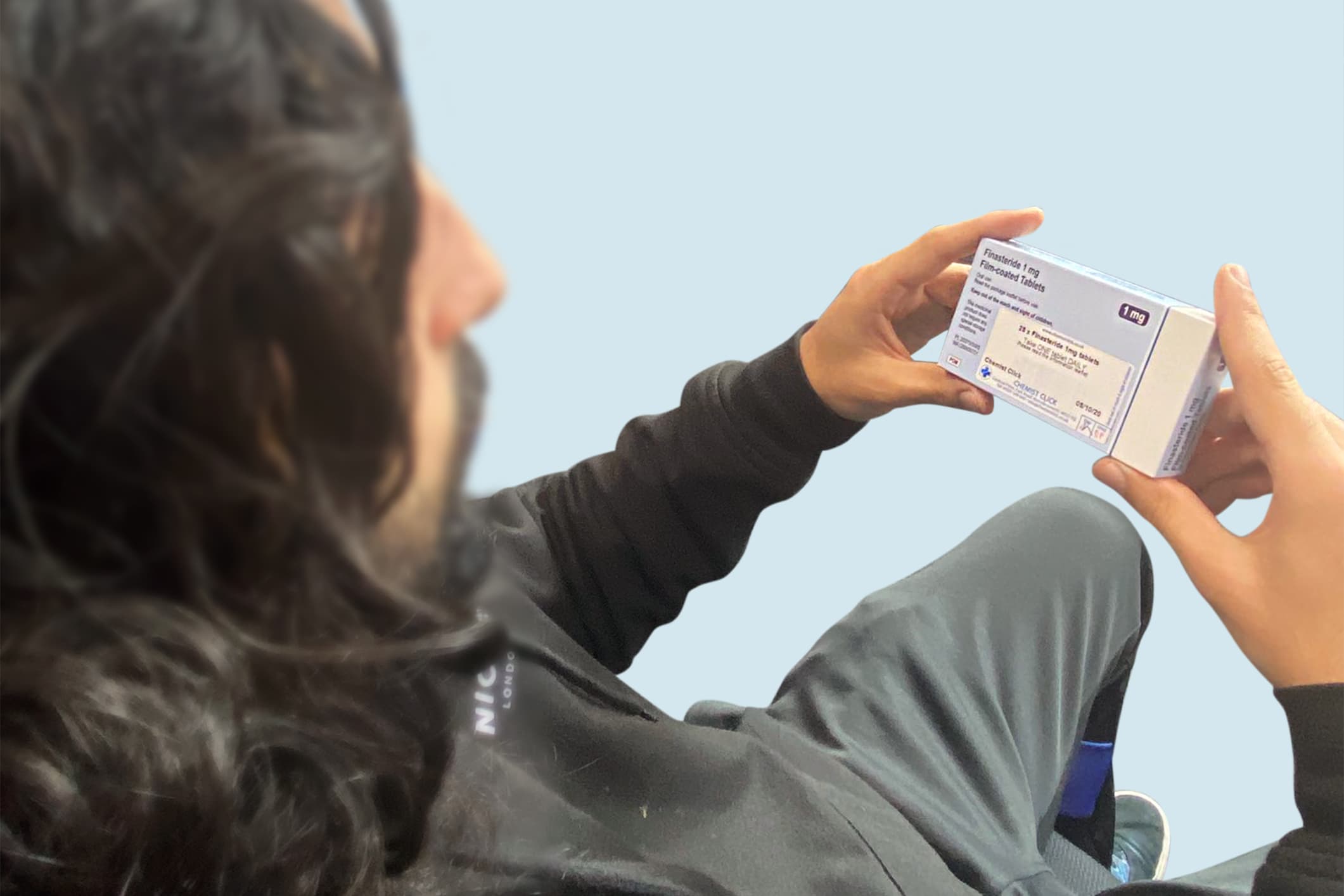Oral vs. Topical Finasteride

Content by

Last Updated
Start a Consultation Today
See our range of Men's Hair Loss Treatments
Finasteride 1mg Tablets delivered discreetly from our UK Pharmacy.
Androgenetic alopecia (male or female pattern baldness) is a distressing hair loss condition, affecting up to 50% of men and women worldwide. It appears as progressive hair thinning or loss around the crown and temple areas of the head in men and as a wider central parting in women. [1]
Finasteride is a first-line medication for androgenetic alopecia, preventing further hair loss and restoring hair density. Either oral or topical Finasteride can be used. The big question is which one is better? In this blog, we cover the key differences between oral Finasteride and topical Finasteride including cost, side effects and efficacy.
Table of Contents
- What is the Difference Between Oral and Topical Finasteride?
- Oral vs. Topical Finasteride: Dosage
- Oral vs. Topical Finasteride: Side Effects
- Oral vs. Topical Finasteride: Cost
- Is Oral Finasteride More Effective Than Topical Finasteride?
- Should You Take Oral or Topical Finasteride?
What is the Difference Between Oral and Topical Finasteride?
Finasteride is available in two different forms: oral and topical. In most cases with male pattern baldness, patients are prescribed oral Finasteride 1mg tablets. It works by blocking an enzyme called ‘5-alpha-reductase’ which turns testosterone into dihydrotestosterone (DHT). Scientists still don't fully understand it, but the DHT hormone plays a major role in causing androgenetic alopecia. By limiting DHT levels, hair loss can be prevented and hair growth can be improved. Finasteride 1mg is FDA-approved and UK-licensed for male pattern baldness. This means the use of oral Finasteride is not recommended for women.
Topical Finasteride comes in a gel or liquid solution which is applied directly to the affected scalp area. It works similarly to oral Finasteride, but only in the applied hair follicles. Topical Finasteride contains a lower percentage of active ingredient (0.1% Finasteride or less) and it is often combined with other hair loss ingredients such as topical Minoxidil. It is not yet FDA-approved or UK-licensed as there is not enough evidence, but it can be used by both men and women with androgenetic alopecia. Oral or topical Finasteride is not recommended for pregnant or breastfeeding women.
Oral vs. Topical Finasteride: Dosage
The usual dosage of oral Finasteride is one 1mg tablet to be taken daily with water to treat male pattern baldness. On the other hand, topical Finasteride does not have an approved dosage because it can vary depending on the formulation and concentration of the product. Typically, the usual dosage for topical finasteride is 1ml applied to the affected area once or twice daily.
Oral vs. Topical Finasteride: Side Effects
Oral and topical Finasteride are two different forms, meaning the side effects can vary.
Oral Finasteride may cause the following side effects:
- Low sex drive
- Erectile dysfunction
- Decreased ejaculate volume
- Breast pain, tenderness or swelling
- Nipple discharge
- Low mood or depression
If side effects do occur, they usually disappear after a while. Less common side effects such as breast pain, swelling or nipple discharge have been linked to rare cases of breast cancer in men. If you notice any concerning side effects while taking oral Finasteride, talk to your healthcare provider. [2]
Topical Finasteride may cause the following side effects:
- Scalp irritation, itching or burning
- Contact dermatitis
- Dryness or flakiness of the scalp
- Redness or inflammation in the applied areas
- Headaches
- Decreased sex drive
- Erectile dysfunction
As topical Finasteride is applied to the scalp and not taken orally, it is less likely that side effects will occur. While most of the side effects seem mild, there is a chance that topical Finasteride could cause side effects similar to oral Finasteride such as decreased sex drive or erectile dysfunction.
Like all medications, some users may be allergic to Finasteride, whether that is the oral or topical form. If you suddenly notice swelling, hives, skin rashes, difficulty breathing or swallowing, dizziness or feeling faint, stop the medication and seek medical attention immediately.
Oral vs. Topical Finasteride: Cost
Oral and topical Finasteride can be expensive because it is not available on the NHS, but it can be purchased through a private prescription. Patients can expect to pay the full price for the medication. [3]
As of August 2024, leading UK pharmacies charge between £14 to £60 for a 28-tablet box of oral Finasteride 1mg (4-week supply). At Chemist Click, a 28-tablet box of Finasteride 1mg starts from £13.89.
Topical Finasteride is generally not found in UK pharmacies, it may have to be ordered online. A 60 ml bottle of topical Finasteride can cost between £25 and £50, depending on the formulation or brand.
Is Oral Finasteride More Effective Than Topical Finasteride?
Both oral and topical Finasteride have shown effective results in treating androgenetic alopecia. However, oral Finasteride is more widely studied and may provide slightly more effective results.
In a study, the use of oral Finasteride 1mg/daily was conducted on 1,879 men aged 18 and 41 years with mild to moderate male pattern baldness. After 1 year, 48% of men found an improvement in hair growth. After 2 years, there was a further hair growth improvement in 66% of men. A 16% increase in hair count was also found. [4]
To test the efficacy of topical Finasteride, 28 men and 24 females with androgenetic alopecia were randomised to receive either a 1ml topical Finasteride 0.005% solution or a placebo twice daily to the affected scalp for 16 months. The study found a significant decrease in the rate of hair loss in the topical Finasteride group, compared to the placebo group. [5]
Should You Take Oral or Topical Finasteride?
In most cases, oral Finasteride is prescribed to male patients. However, there are specific reasons why patients may be prescribed to use topical Finasteride.
Oral Finasteride is a better choice if you are a man suffering from male pattern baldness and you want to use an FDA-approved and UK-licensed medication. On the other hand, topical Finasteride may be the better choice if you are a woman with female pattern baldness, you are worried about the side effects of oral Finasteride, or you want to maintain hair growth after a course of oral Finasteride.
It is not recommended to take both oral Finasteride tablets and a topical Finasteride solution at the same time. While you may think it can boost hair growth results, it can boost the chances of side effects from happening instead. If you are unsure whether to use oral or topical Finasteride, please consult with your healthcare provider.
Sources
- National Library of Medicine (Updated 2024). Androgenetic Alopecia. Retrieved on 22nd August 2024, from: https://pubmed.ncbi.nlm.nih.gov/28613674/
- NHS (n.d.). Side Effects of Finasteride. Retrieved on 22nd August 2024, from: https://www.nhs.uk/medicines/finasteride/side-effects-of-finasteride/
- NHS (n.d). Common questions about Finasteride. Retrieved on 22nd August, from: https://www.nhs.uk/medicines/finasteride/common-questions-about-finasteride/
- ScienceDirect. (2015). Use of Finasteride in the Treatment of Men With Androgenetic Alopecia (Male Pattern Hair Loss). Retrieved on 22nd August 2024, from: https://www.sciencedirect.com/science/article/pii/S0022202X15529357/
- J Drugs Dermatol. (2018). A Systematic Review of Topical Finasteride in the Treatment of Androgenetic Alopecia in Men and Women. Retrieved on 22nd August 2024, from: https://www.ncbi.nlm.nih.gov/pmc/articles/PMC6609098/pdf/nihms-1035387.pdf
Whilst all of our content is written and reviewed by healthcare professionals, it is not intended to be substituted for or used as medical advice. If you have any questions or concerns about your health, please speak to your doctor.
